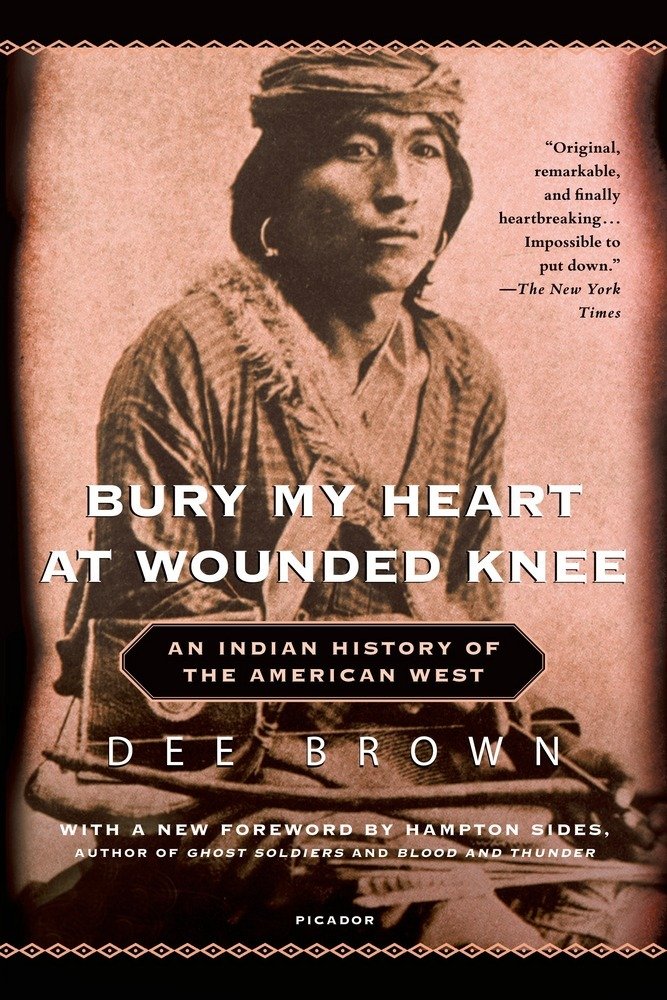Complete Literary Analysis
📖 Overview
Published in 1970, Bury My Heart at Wounded Knee revolutionized the way Americans understood their own history. Dee Brown meticulously chronicles thirty years of Native American displacement, broken treaties, and cultural genocide from 1860 to the massacre at Wounded Knee in 1890. By centering indigenous voices and perspectives, Brown challenged the triumphalist narrative of westward expansion and forced readers to confront the brutal reality of Manifest Destiny.
The book spans eighteen chapters, each focusing on different tribes—from the Navajo and Apache in the Southwest to the Sioux and Cheyenne on the Great Plains. Through extensive use of Native American testimony, council records, and firsthand accounts, Brown reconstructs these tragic events with unprecedented authenticity and emotional power.
👥 Key Historical Figures
Chief Sitting Bull (Sioux)
Role: Spiritual and military leader of the Lakota people
Significance: Led resistance against U.S. encroachment, including the Battle of Little Bighorn. His eventual surrender symbolized the end of Plains Indian independence.
Chief Crazy Horse (Sioux)
Role: Legendary warrior and tactician
Significance: Never signed a treaty with the U.S. government; killed while in custody, representing unwavering resistance to conquest.
Chief Joseph (Nez Perce)
Role: Diplomatic leader forced into war
Significance: Led the famous 1,170-mile fighting retreat toward Canada, delivering the poignant surrender speech: "I will fight no more forever."
Geronimo (Apache)
Role: Apache resistance leader
Significance: His guerrilla warfare tactics prolonged Apache independence; his final surrender in 1886 marked the last major armed resistance.
Red Cloud (Sioux)
Role: Strategic leader and negotiator
Significance: Won Red Cloud's War, forcing the U.S. to abandon forts along the Bozeman Trail—one of the few Native American military victories.
💭 Central Themes
⚖️ Systematic Betrayal
The U.S. government made and broke over 400 treaties with Native tribes. Brown documents how promises of land, food, and sovereignty were consistently violated for economic and political gain.
🏔️ Cultural Genocide
Beyond physical violence, the book reveals deliberate efforts to destroy Native languages, religions, social structures, and economic systems—particularly through forced assimilation and reservation policies.
💪 Resilience & Resistance
Despite overwhelming odds, Native peoples demonstrated extraordinary courage, strategic brilliance, and determination to preserve their way of life and dignity.
📜 Historical Revision
Brown challenges the "frontier myth" that portrayed westward expansion as heroic progress, revealing it as violent conquest built on racial ideology and economic exploitation.
🌍 Land & Spirituality
The profound connection between Native peoples and their ancestral lands contrasts sharply with settler views of land as commodity—a fundamental clash of worldviews.
🔴 Manifest Destiny's Cost
The ideology justifying expansion as divinely ordained is exposed as a rationale for genocide, revealing how nationalism can enable atrocity.
✍️ Writing Style & Approach
🔑 Key Methodological Innovations:
- Voice-Centering: Extensive use of Native American speeches, testimony, and council records gives indigenous people agency in their own story
- Chronological Structure: Moving through three decades allows readers to see the systematic nature of displacement
- Tribal Specificity: Each chapter focuses on particular nations, honoring their distinct cultures and experiences rather than treating them as monolithic
- Document Citations: Rigorous sourcing from government records, military reports, and eyewitness accounts provides irrefutable evidence
🎯 Historical Context & Impact
Publication Context (1970)
The book appeared during the Vietnam War era, when Americans were increasingly questioning government narratives and military actions. The parallels between Vietnam and Indian Wars resonated powerfully with readers, contributing to the book's immediate bestseller status.
Cultural Impact
- Stayed on the New York Times bestseller list for over a year
- Influenced the American Indian Movement and indigenous rights activism
- Changed how U.S. history was taught in schools nationwide
- Inspired countless documentaries, films, and subsequent historical works
- Sparked national conversation about historical memory and reparations
📚 Key Events Covered
⭐ Final Verdict
Overall Rating: ⭐⭐⭐⭐⭐ (5/5)
An essential, transformative work of American history that demands to be read. Brown's meticulous research and compassionate storytelling make this painful history accessible and impossible to ignore.
🎯 Strengths
- Groundbreaking use of Native sources
- Compelling narrative despite tragic subject
- Meticulous documentation
- Challenges accepted historical narratives
- Accessible to general readers
⚠️ Considerations
- Emotionally difficult material
- Some critics note occasional romanticism of Native life
- Limited coverage of tribes outside the West
- Written from 1970 perspective; newer scholarship has expanded some narratives
📚 Recommended For
- American history students
- Readers interested in indigenous perspectives
- Those examining historical injustice
- Anyone seeking to understand the true cost of westward expansion
🤔 Critical Reception & Legacy
While some historians initially questioned Brown's methodology, the book has endured as a foundational text in Native American studies. Its emotional power and accessibility brought indigenous history to millions of readers who might never have engaged with academic texts. Contemporary Native scholars have both praised its advocacy and critiqued its occasional externalization of Native voices—it tells their story powerfully, but still from an outsider perspective.
Nevertheless, Bury My Heart at Wounded Knee fundamentally changed American historical consciousness. It made denial of indigenous genocide intellectually untenable and paved the way for more nuanced, Native-authored histories that followed.
💬 Memorable Quotes
"They made us many promises, more than I can remember, but they never kept but one; they promised to take our land, and they took it."
"I will fight no more forever."
📱 Enhance Your Reading Experience
Reading powerful history like this? Organize your library and keep all your important books in one place with 🚀 Bookerei - the ultimate ebook reader and management app. Make notes, highlight passages, and build your personal library of essential reads.
Get Bookerei📚 Related Analysis
To Kill a Mockingbird
Another American classic confronting racial injustice and moral courage.
The Stranger
Exploring themes of alienation and society's judgment of the outsider.

